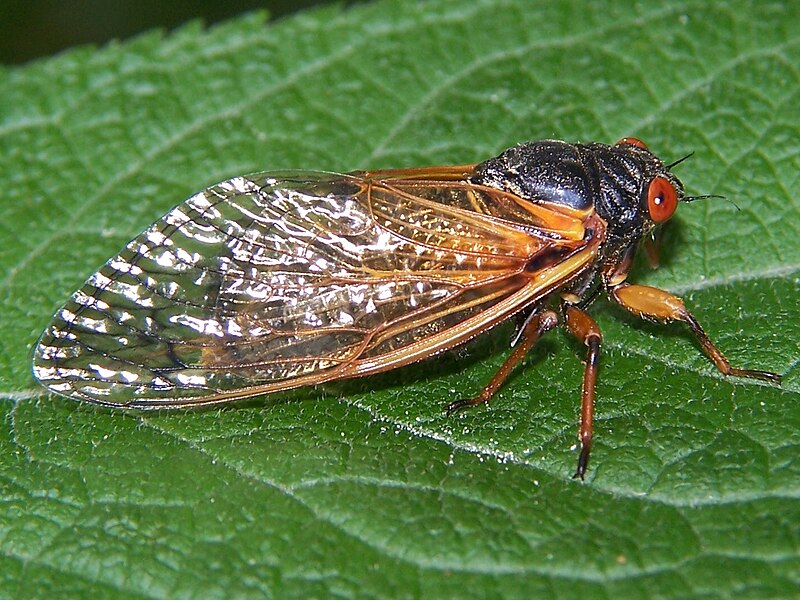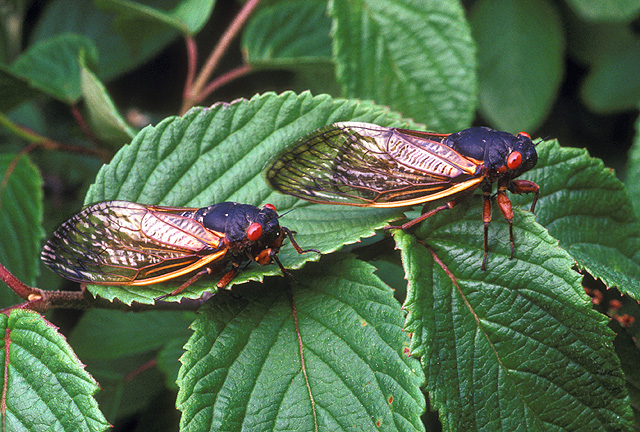 |
| Magicicada adults and final stage nymphs. Photo credit: Arthur D. Guilani |
I'm talking about the emergence of the so-called 17-year locust. Actually, it isn't a locust at all, which is a member of the grass-hopper and cricket family, but a cicada, which is closer to the aphids. The first Europeans in America to witness an emergence had heard of biblical plagues of locusts but had no real idea what a locust was, and assumed they were witnessing a similar biblical plague and called the cicadas locusts.
The 17-year cicada is a member of the Magicicada genus, or periodical cicadas of which there are seven species, three of which have a 17-year life-cycle and four a 13-year cycle.
Magicicada is the genus of the 13-year and 17-year periodical cicadas of eastern North America. Although they are sometimes called "locusts", this is a misnomer as cicadas belong to the taxonomic order Hemiptera, while locusts belong to Orthoptera.
Magicicada spp. spend most of their 13- and 17-year lives underground feeding on xylem fluids from the roots of deciduous forest trees in the eastern United States. After 13 or 17 years, mature cicada nymphs emerge at any given locality, synchronously and in tremendous numbers. After such a prolonged developmental phase, the adults are active for about 4 to 6 weeks. The males aggregate into chorus centers and attract females for mating. Within two months of the original emergence, the life cycle is complete, the eggs have been laid and the adult cicadas are gone for another 13 or 17 years.
Source: Wikipedia - Periodical cicadas
 |
| 17-year Magicicada sp. Brood XIII, 207. Photo credit: Bruce Marlin |
Male Magicicadas, the ones which emit the sound by using a pair of tybals on their abdominal wall, have some success deterring birds and other predators with a barrage of noise but the silent females merely drop to the ground and hide in the undergrowth. Neither of these is very effective however and a whole range of predatory birds, mammals, fish, snakes, even turtles, gorge themselves on cicadas when they emerge, often in millions or billions over a relatively small area. And this is the periodical cicadas' survival strategy, or rather the survival strategy of periodical cicada genes.
The strategy adopted is one of predator satiation. During the few weeks that adult cicadas are active, predators eat their fill and can literally eat no more. In effect, the cicada genes pay a tax in the form of a percentage of their carriers (cicadas) so that enough will survive to produce the next generation of cicada genes.
 |
| 17-year Magicicada septendicima |
In fact there seems to be just one predator species which has managed to synchronise with the periodical cicada, in the form of a fungus which lives in the nymphs for the duration of their subterranean existence, producing spoor which remain in the soil as the final nymph matures and leaves the soil to climb a tree to become the winged adult. The spoors then infect the next generation as they burrow down into the soil to start the next subterranean population.
Quite frequently there will be a few straggler emergings of periodical cicadas a year either side of the main emerging but these are usually quickly mopped up by predators because their numbers are never large enough to satiate them, so these rarely breed. In effect, genes favouring early of late emergence, and nascent new species with these periods rapidly go extinct due to predation.
However, due probably to an acceleration in one of the nymph stages facilitated by favourable conditions, an early emergence at 13 years instead of the normal 17 is quite common and often in substantial numbers. Normally, these too produce few breeding successes due to low numbers but very occasionally, and on at least one occasion for each of the 17-year species in the last few million years, this has produced a viable, sustainable population of 13-year cicadas. Hence, for every 17-year species there is a closely similar 13-year species (two in the case of the 'decima' form). These species have names reflecting their periodicity and their relationship.
This then is an example of the selfish gene in action. It has suited the survival 'needs' of cicada genes to adopt the predator satiation strategy with no regard for the individual carrier of those genes. All that matters is that the genes survive in the next generation and any strategy which produces more descendants will, well, produce more descendants, so genes producing that strategy will prosper in the species gene-pool.
So, that explains the synchronized emergence of very large numbers and the long life-cycle. What is harder to understand is that the number of years is a prime number.
A clue to this is in the nature of prime numbers. A prime number is a number that is only divisible by itself and 1. This means that any competitor or predator with a long life-cycle can't synchronize with a 13-year or 17-year cicada other than with a 13 or 17-year life-cycle. For example, a two-year life-cycle would only be in synchronization with the 17-year cicada every 34 years; a three year life-cycle every 51 years.
Sophisticated mathematical models have shown how, given a long life-cycle, a predator satiation survival strategy and populations competing for the same resources, stable populations with a synchronized prime number periodicity will tend to form.
It also means that, once a 13-year form has become established, it will only hatch in the same year as a 17-year form every (13*17) years, or 221 years, so they exist, for the most part as isolated gene-pools. Biologists have long debated whether this makes the 13 and 17-year forms separate species according to a biological definition of non-interbreeding populations. Charles Darwin was of the opinion that this possible interbreeding every 221 years was enough to make these merely forms of the same species. Current thinking, based on genetic evidence, and on the fact that the two forms do not in fact normally interbreed due to different mating rituals, including different sounds made by the males, is that 13 and 17-year forms are in fact distinct biological species.
This is, of course, an example of how the man-made definition of 'species' is not always appropriate. Certainly, nature doesn't read the rule book, making Creationist pontification about micro- and macro-evolution utterly absurd. We can readily see in the 13 and 17-year periodical cicadas how one ancestral species can give rise to two daughter species by the operation of environmental factors acting on genetic variation.
Can any Creationist who has survived this far suggest how this story fits with an intelligent design notion? What is the purpose of producing a super-abundance of food once every 13 or 17 years which, if it makes any difference to bird, mammal, fish, snake or turtle populations in a geographical location, only creates a surplus to starve next year when the cicadas have gone? What is the purpose of cicadas which do little other than feed moles for almost all of their lives, slightly reduce the growth rate of trees and act as hosts for a fungus which does nothing other than produce fungi?
If you live in the Eastern USA, go outside any day soon to be reminded of how evolution works and enjoy the results of a perfectly natural process producing one of the great spectacles of the natural world.
Further reading:
The University of Michigan Museum - Periodical Cicada Page.

No comments:
Post a Comment
Obscene, threatening or obnoxious messages, preaching, abuse and spam will be removed, as will anything by known Internet trolls and stalkers, by known sock-puppet accounts and anything not connected with the post,
A claim made without evidence can be dismissed without evidence. Remember: your opinion is not an established fact unless corroborated.